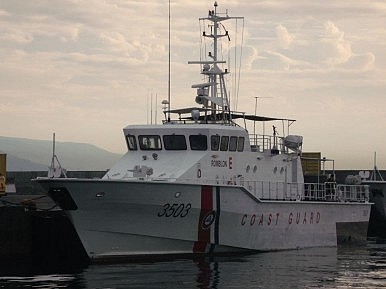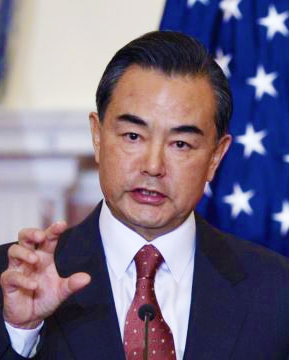From The Diplomat (Jul 14):
Why the Philippines Needs More Than Just Military Upgrades (By Jay Tristan Tarriela)
Modernizing the Coast Guard is an urgent (but neglected) task for the archipelagic state.
 Image Credit: Wikimedia Commons/ Lieutenantpdg
Image Credit: Wikimedia Commons/ Lieutenantpdg
In 2012, the Philippines deployed its Navy’s flagship, BRP
Gregorio del Pilar, to apprehend Chinese fishing vessels and arrest fishermen who had poached critically endangered sea turtles and other marine creatures in the Scarborough Shoal, a disputed feature in the South China Sea previously under the exclusive control of Manila. It must be noted that sending its warships to conduct law enforcement patrols was nothing new for the Philippines. In fact, the country’s Navy had routinely apprehended Chinese fishermen in the Scarborough Shoal and the Spratlys in the past. Manila’s civilian maritime law enforcement agency, the Philippine Coast Guard (PCG), lacked the capability to traverse waters beyond the country’s territorial sea. Considering the Scarborough Shoal’s 220-kilometer distance from the nearest Luzon landmass, PCG could not possibly patrol the area. China’s decision, however, to respond by sending white vessels from China Marine Surveillance, a paramilitary maritime law enforcement agency under its Transport Ministry, was something new. It resulted in a standoff, which eventually led to a new status quo, albeit ambiguous, in favor of Beijing.
The 2012 incident that disadvantaged Manila was just one manifestation of the country’s security challenges, brought about by the so-called tyranny of geography. After all, the Philippines is an archipelagic nation with some 7,500 islands and a 36,000-kilometer coastline.
First, it borders China, a fast rising great power and an increasingly threatening neighbor. As a U.S.-treaty ally loudly disputing Beijing’s claim to over 80 percent of the South China Sea, the Philippines is proving to be a serious obstruction to China’s maritime ambitions and aspirations. Second, while the archipelago is inhabited by 100 million Filipinos, the islands are so dispersed over a wide area that monitoring maritime activities has proven to be an impossible job for government forces. The occasional kidnapping of tourists by the notorious Abu Sayyaf Group from resorts in Sabah and Mindanao highlights this point. Finally, the location of the country itself means that many parts of it are prone to natural disasters. For instance, around 20 typhoons batter the country each year, necessitating massive evacuations and post-disaster rescue and relief operations. These are the security challenges of maritime Philippines.
Apart from the on-going Armed Forces of the Philippines (AFP) Modernization Program, fast-tracked by the previous Aquino Administration, there seems to be nothing else significant on the table to address these issues. But Manila’s three-pronged security challenge – internal security, natural disasters, and maritime security in the South China Sea – is complex and multilayered. It calls for a more comprehensive approach that should not rely exclusively on military upgrades.
While billions of dollars are being spent on the ill-equipped AFP, there seems to be a lack of attention to civilian maritime forces. In fact, the last major hardware acquisition of the PCG was in 2004. This is peculiar given that the Philippines is a maritime state. Last year, the national budget passed by Congress included allocations for two choppers intended for PCG. Nothing materialized.
Coast Guard Surface Assets
A quick review of current PCG inventory could easily expose the Philippines’ lack of capability to patrol its coastline, the fifth longest in the world, to guard its UN Convention on the Law of the Sea-mandated exclusive economic zones (EEZ) and other entitlements, and to respond to contingencies, such as law enforcement and search and rescue, in Philippine-controlled maritime areas.
The Coast Guard has a 60-meter vessel acquired from Japan in 1999. It has eight Search and Rescue Vessels (SARVs) – four 35-meter vessels and another four 56-meter vessels – acquired through a soft-loan from Australia in 2000. In 2004, the Bureau of Fisheries and Aquatic Resources (BFAR) received a soft loan from Spain for the construction of ten 30-meter Monitoring, Controlling and Surveillance (MCS) boats and four 11-meter MCS boats. These assets are jointly being operated by BFAR and PCG in fulfilling their interlinked mandates. It must be noted however, that none of these surface assets could patrol beyond the country’s territorial waters for a long period of time. These SARVs and MCS boats are also not big enough and not equipped to withstand weather disturbances and difficult sea currents. Their reliability and operational capability have gradually deteriorated as they age.
In addition to those relatively newer surface assets, the PCG also has 34 older small crafts, many of them with serious operational and maintenance issues. Meanwhile, PCG’s three buoy tender vessels (AE-79, AE-89, AE-46) and a lone patrol gunboat (PG-64), which were once part of the Philippine Navy’s fleet, are no longer operational and are considered beyond repair.
Need for Coastguard Modernization
While it is understandable for Manila to focus on military upgrades, the complexity of the Philippines’ security challenges require that it also provide a renewed attention to its civilian maritime law enforcers.
First, as mentioned above, China’s increasing assertiveness in the South China Sea will remain to be the country’s biggest traditional security challenge in the years to come. For some time now, Beijing has been conspicuously using civilian maritime law enforcement vessels to enforce its claim and change the status quo of disputed features to its favor. These vessels are large, many of them armed, and are capable of traversing the high seas. In terms of sheer numbers, China has the biggest coast guard fleet in the world with an estimated total tonnage of more than 500,000. In addition to government vessels, China has also been notorious in recent years for using “
maritime militia” or simply civilian fishing boats to create new facts in areas it wants to control.
How then should Manila respond? Manila cannot afford to be accused of “militarizing” the South China Sea disputes by dispatching warships to the areas it controls. Doing so would provide Beijing yet another opportunity to reverse status quos. Hence, what Manila really needs is a fleet of highly capable Coast Guard vessels that could patrol its maritime entitlements in the South China Sea, in particular the waters surrounding Scarborough Shoal and the Spratlys. This is particularly important considering the likely favorable decision of the Permanent Court of Arbitration in The Hague on Manila’s case against Beijing’s nine-dash line in the South China Sea.
Also, a highly equipped PCG could complement the AFP’s “minimum credible defense posture,” maintain constant presence indicating effective control and jurisdiction on Philippine-controlled maritime zones, and deter illegal fishing, while at the same time avoiding escalation of conflicts.
Second, a strong Coast Guard is imperative for the Philippines’ fulfillment of its obligations under international law and its regional security responsibilities. On the former, UNCLOS mandates coastal states to provide maritime and aviation search and rescue services and repression of piracy on the high seas or in any other place outside the jurisdiction, among other responsibilities. This is particularly important given that Southeast Asia has been a maritime piracy
hotspot for some time now. The Philippines also has the responsibility to counter and to prevent the proliferation of WMDs provided for by international strategic trade control regimes. Hence, for the fulfillment of all these tasks, Manila should have the capability to track, chase, and regulate the passage of ships within its maritime area of responsibility. Moreover, for the country to benefit from UNCLOS-mandated economic entitlements, it is important for Manila to have the capability to enforce its laws and protect marine biodiversity.
A constant presence of highly equipped Coast Guard vessels could go a long way in preventing extremist groups, such as Abu Sayyaf from carrying out their usual kidnapping, often from resorts in Sabah. A highly capable PCG bodes well for the blossoming non-traditional security
cooperation among the Philippines, Indonesia, and Malaysia, an important step in preventing the Islamic State from increasing its presence in the areas surrounding the Sulu and Celebes Seas.
Third, boosting PCG significantly helps in disaster preparedness. Typhoon Haiyan in late 2013 exposed how the government’s limited resources hindered its ability to respond rapidly and effectively to catastrophes. The massive relief operations in the aftermath of the super typhoon required air and maritime assets for the transport of relief goods and medical supplies, and the relocation of victims, assets that the Philippines simply did not have. Highly equipped Coast Guard vessels, choppers, and equipment could prove to be useful during evacuations and post-disaster search, rescue and relief operations.
Policy Prescription: Rapidly Modernize PCG
The Philippines’ decision to tap Japan for the construction of ten 40-meter Multi-Role Vessels (MRV) for civilian maritime law enforcement is a step in the right direction. Needless to say, these new vessels will enable PCG to fulfill its mandates and extend its operations even up to Philippine-controlled areas of the South China Sea. However, it must be recalled that, for at least three years, the project languished from bureaucratic
delays or perhaps indecision. First agreed upon in 2011, construction only began in 2015 and the first of the ten vessels has not even been delivered yet. Manila needs a sense of urgency in concluding similar agreements in the future.
Indeed, the Japan deal should not be the be-all and end-all of PCG modernization. The new Duterte administration should be able to conclude similar agreements with other countries to further PCG’s capability upgrades and reach. For instance, offshore patrol vessels will still be needed in order to sustain a longer and continuous presence in those areas controlled by the Philippines. PCG also lacks radar facilities for full maritime domain awareness, as well as surveillance, search and rescue equipment.
But relying on soft loans cannot be Manila’s exclusive mode of PCG modernization. It has to increase budget allocations for its maritime law enforcement commensurate to its status as a rapidly developing maritime state. Since the PCG is under the Transportation Ministry, it should be relatively easier and less sensitive for the government to justify increased budget allocation. The next big step should therefore be for President Duterte to push for the PCG Modernization Bill in Congress and certify such as “urgent,” the same manner in which Aquino treated the AFP Modernization.
Not solely relying on overseas development assistance and soft loans for PCG modernization also means that other acquisitions could be built locally. The Philippines, the fourth largest shipbuilding nation in the world, is certainly capable of locally sourcing civilian vessels. Not only is it politically sound, since doing so would create local employment and boost the local economy, it is also cost-effective.
Finally, parallel to PCG’s physical upgrades, the Philippines should also proactively engage its peers in the region, from Japan and China to ASEAN and Australia for policy coherence, common understanding of international maritime norms, regimes, and other codes of acceptable behaviors, and increased cooperation. By so doing, it could effectively influence civilian maritime law enforcement standards and dissuade countries from using their Coast Guards to challenge the status quos of disputed maritime zones and from imposing new restrictions on the high seas, helping guarantee freedom of navigation.
Overall, the Philippines should pay closer attention to its Coast Guard and see the agency’s potential to help address many of the country’s traditional and non-traditional security challenges.
[Jay Tristan Tarriela is a Philippine Coast Guard Officer and a Master of Public Policy Candidate at the Graduate Institute for Policy Studies, Tokyo. Jeffrey Ordaniel is a PhD Candidate at the Security and International Studies Program of the Graduate Institute for Policy Studies, Tokyo, and a Young Leader with Pacific Forum CSIS, Honolulu.]
http://thediplomat.com/2016/07/why-the-philippines-needs-more-than-just-military-upgrades/



.png)
.png)

